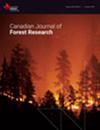原木护岸对菲沙河下游和河口的物理生境、水质和底栖无脊椎动物的影响
IF 1.7
3区 农林科学
Q2 FORESTRY
引用次数: 0
摘要
在太平洋西北部的一些地区,为了方便木材的运输和加工,人们将原木捆绑在一起,形成大型矩形筏(通常称为 "围木"),然后将其运输并储存在水生环境中。在不列颠哥伦比亚省弗雷泽河下游,一些河段有超过 50% 的海岸线毗邻原木栅栏,但我们对原木栅栏对栖息地和生物群影响的了解却非常有限。我们将从未使用过原木围油栏的地点与附近正在使用围油栏的地点进行了比较,以考察环境特征的差异。与参考地点相比,几乎所有的活动地点都有压实的沉积物和很少的植被覆盖,这可能是由于受潮汐影响的水位变化导致原木 "接地 "造成的。参考点的底栖无脊椎动物总丰度较高,因为参考点有相对较多的两足类和三足类,但单足类较少,而活跃点的沉积物压实且含更多的碎屑,应有利于单足类的生长。参考点和活跃点的水质变量一般没有差异。原木围油栏的接地以及与下方底质的接触违反了最佳管理方法,对围油栏下方区域的自然生境和生物群落有明显影响。本文章由计算机程序翻译,如有差异,请以英文原文为准。
Effects of log booms on physical habitat, water quality, and benthic invertebrates in the lower Fraser River and estuary
To facilitate the movement and processing of timber in some regions of the Pacific Northwest, logs are tied together to form large rectangular rafts (often called “booms”) which are transported and stored in aquatic environments. In the lower Fraser River, British Columbia, some reaches have >50% of shoreline with adjacent log booms, yet our understanding of the effects of log booms on habitats and biota is very limited. We compared sites that have never had log booms to nearby ones with active boom storage occurring to examine differences in environmental characteristics. In contrast to reference sites, nearly all active sites had compacted sediments and little vegetation coverage, likely caused by logs “grounding” onto benthic environments due to tidally influenced water level changes. Total benthic invertebrate abundance was higher at reference sites which had relatively more Amphipoda and Trichoperta, but fewer Haplotaxida, compared to active sites whose compacted and more detrital-laden sediments should favour haplotaxids. Water quality variables generally did not differ between reference and active sites. Grounding of log booms and contact with the below substrate is in contradiction of best management practices and has clear effects on the physical habitat and biota of the area underneath booming sites.
求助全文
通过发布文献求助,成功后即可免费获取论文全文。
去求助
来源期刊
CiteScore
4.20
自引率
9.10%
发文量
109
审稿时长
3 months
期刊介绍:
Published since 1971, the Canadian Journal of Forest Research is a monthly journal that features articles, reviews, notes and concept papers on a broad spectrum of forest sciences, including biometrics, conservation, disturbances, ecology, economics, entomology, genetics, hydrology, management, nutrient cycling, pathology, physiology, remote sensing, silviculture, social sciences, soils, stand dynamics, and wood science, all in relation to the understanding or management of ecosystem services. It also publishes special issues dedicated to a topic of current interest.

 求助内容:
求助内容: 应助结果提醒方式:
应助结果提醒方式:


